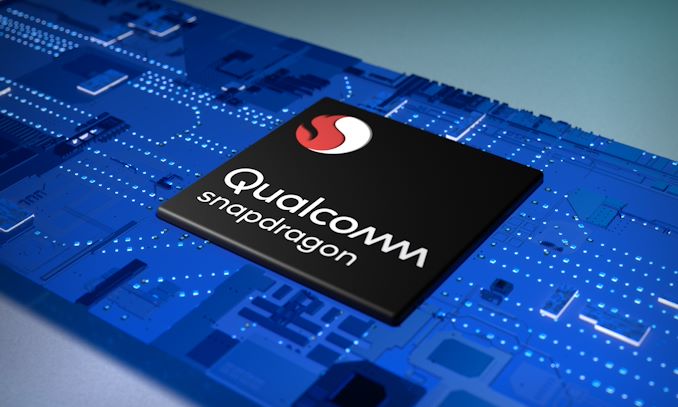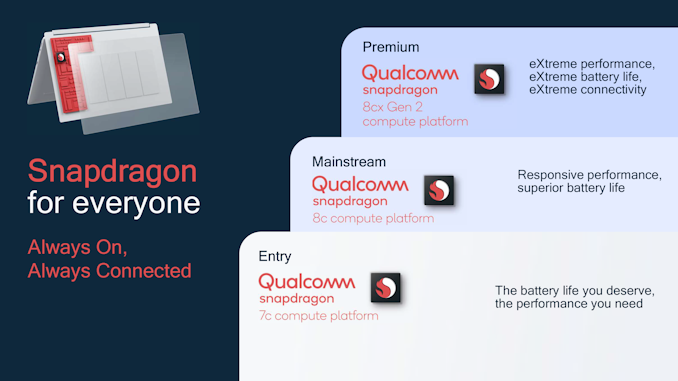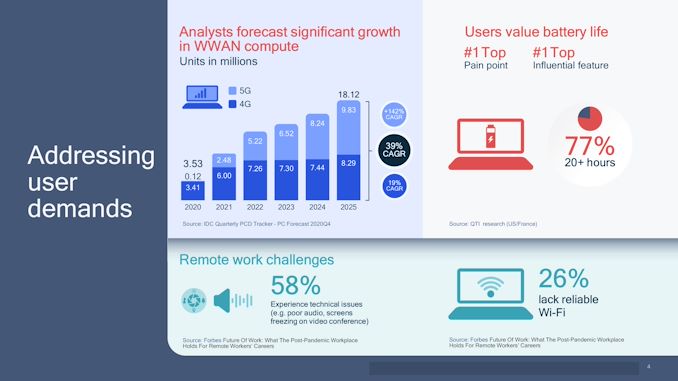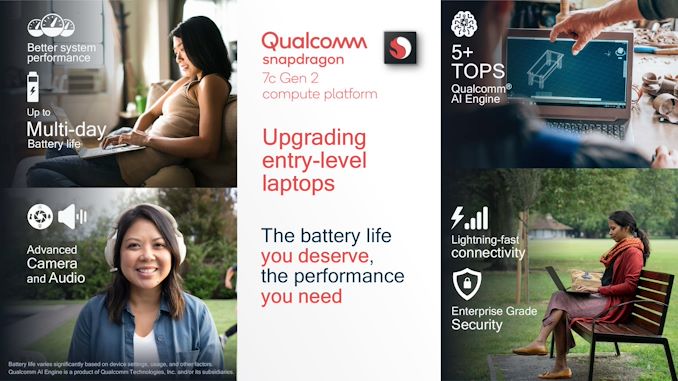Qualcomm Announces Snapdragon 7c Gen 2: Entry-Level PC and Chromebook Refresh
by Ryan Smith on May 24, 2021 11:01 AM EST- Posted in
- SoCs
- Snapdragon
- Qualcomm
- Chromebook
- Laptops
- Cortex-A76
- Snapdragon 7c

As part of their Scaling the Mobile Compute Ecosystem presentation, Qualcomm this morning is announcing a refreshed version of their Snapdragon 7c for laptops. Aptly named Snapdragon 7c Gen 2, the updated chip for entry-level Windows PCs and Chromebooks sports a slight clockspeed boost, bumping the frequency of the two Kryo 468 (Cortex-A76) cores up to 2.55GHz. Spec bumps aside, Qualcomm’s target market for the 7c family hasn’t changed, with the updated SoC designed to serve as an anchor for sub-$400 “always-on” devices.
The original Snapdragon 7c was announced back at Qualcomm’s 2019 tech summit, as part of Qualcomm’s efforts to flesh out their lineup of Snapdragon Compute SoCs aimed at Arm-powered PCs and other laptops. At the time, Qualcomm was (and still is) gunning heavily for making a market of always-on Windows devices, taking advantage of the low power consumption of Qualcomm’s chips and integrated LTE modem to deliver a mobile-like platform for Windows PCs. Those efforts, though not a smash hit, have at least proven fruitful enough for Qualcomm to refresh parts of the Snapdragon Compute lineup while better bringing Chromebooks into the fold as well.
To that end, the Snapdragon 7c is getting what amounts to a mid-generation face lift. Like the Gen 2 update for the 8cx last year, Qualcomm isn’t rolling out a new silicon design for the 7c Gen 2, but they are reaping the benefits of general yield improvements and better binning to ratchet up the clockspeeds. For the 7c Gen 2, the clockspeed on the chip’s two Cortex-A76 cores is being bumped from 2.4GHz to 2.55GHz.
| Qualcomm Snapdragon Compute SoCs | ||||
| SoC | Snapdragon 8cx Gen 2 | Snapdragon 8c | Snapdragon 7c Gen 2 | |
| CPU | 4x Kryo 495 Gold (CA76) 4x Kryo 495 Silver (CA55) Up to 3.15 GHz |
4x Kryo 490 Gold (CA76) 4x Kryo 490 Silver (CA55) Up to 2.45 GHz |
2x Kryo 468 Gold (CA76) 6x Kryo 468 Silver (CA55) Up to 2.55 GHz |
|
| GPU | Adreno 680 | Adreno 675 | Adreno 618 | |
| DSP / NPU | Hexagon 690 | Hexagon 690 | Hexagon 692 | |
| AI Perf Combined | 7 TOPs | 6 TOPs | 5 TOPs | |
| Memory Controller |
8x 16-bit CH LPDDR4X-4266 63.58 GB/s |
4x 16-bit CH LPDDR4X-4266 31.79 GB/s |
2 x 16-bit CH LPDDR4X-4266 15.90 GB/s |
|
| ISP/Camera | Dual 14-bit Spectra 390 ISP 1x 32MP or 2x 16MP |
14-bit Spectra 255 1x 32MP or 2x 16MP |
||
| Decode Encode |
4Kp120 10-bit H.265 HDR Support |
4Kp60 H.265 HDR Support |
||
| Wi-Fi | Wi-Fi 6 + BT 5.1 | Wi-Fi 5 + BT 5.0 | ||
| Integrated 4G Modem | Snapdragon X24 LTE (Category 20) |
Snapdragon X15 LTE (Category 15/13) |
||
| External 5G Modem | Snapdragon X55 (Optional) | -- | ||
| Mfc. Process | 7nm | 7nm | 8nm | |
Feature-wise, the rest of the package is otherwise the same as it was for the original Snapdragon 7c. This includes a dual-channel (32-bit) LPDDR4X memory bus, a Hexagon 692 DSP, a Spectra 255 ISP, and an LTE category 15 Snapdragon X15 modem. The 7c Gen 2 is unabashedly an entry-level platform, with Qualcomm keeping the feature set (and performance) light in order to be price-competitive in the entry-level market.
Overall then, the Snapdragon 7c Gen 2 not much of a bump over the original Snapdragon 7c, but then again Qualcomm isn’t pitching the Snapdragon 7c Gen 2 as a true next-generation successor to the original Snapdragon 7c. Instead, the launch of the 7c Gen 2 is being treated as something of a second launch for the 7c platform, while also letting Qualcomm pivot a bit on their device strategy to chase Windows devices and Chromebooks more equally. From Qualcomm’s perspective, they still have a competitive and desirable product, especially as entry-level devices have been selling like hotcakes over the past year due to the pandemic.
As with the original 7c, Qualcomm’s biggest strengths with the 7c Gen 2 platform are on battery life and the integrated LTE radio. While the performance of a pair of A76 CPU cores is nothing to write home about these days, they are rather power-efficient by PC standards. Meanwhile an integrated modem not only helps to sell the SoC to cost-conscious OEMs, but also security-minded companies that want their devices reachable the bulk of the time.
The competition for this revised SoC first and foremost remains Intel, who is now shipping their Tremont architecture-based Jasper Lake platform. Qualcomm is still looking to snag a piece of Intel’s PC pie, especially as the chip crunch has forced Intel to prioritize shipping high-end (high margin) hardware. And though Jasper Lake will undoubtedly make for stiffer competition than the older Gemini Lake platform, Qualcomm is still counting on battery life as well as their audio and video processing capabilities to give them an edge over Intel.
Wrapping things up, Qualcomm expects devices based on the Snapdragon 7c Gen 2 to be available this summer. Given the hardware similarities to the original 7c, this should make for a relatively seamless transition for Qualcomm’s OEM partners.
Source: Qualcomm



















33 Comments
View All Comments
dwillmore - Monday, May 24, 2021 - link
That is some pretty weak sauce right there. Two useful cores, nerf'ed graphics, and half the memory bandwidth (one quarter that of the new 8 series). That's exceedingly entry level. That wouldn't even make a decent tablet let alone a laptop.A5 - Monday, May 24, 2021 - link
Yeah...they feel like they're treading water until ARMv9? I dunno.mode_13h - Monday, May 24, 2021 - link
ARMv9? They've already released Snapdragons with A77 and A78 cores. Why not at least step up a generation and use A77 cores instead of the A76's?nico_mach - Tuesday, May 25, 2021 - link
They don't want this market. They can't have monopoly profits like with phones, so the pricing will never be right. They can't sell premium devices at least until MS gets their software in order on ARM, yet that's all they've been selling until now, because they don't want to compete. They think the phone OEMs are captive and why bother giving up money for a less profitable market?eastcoast_pete - Monday, May 24, 2021 - link
Yup! These 7cx look like QC's approach to "reduce, reuse, recycle". At the current level, they only scare Atom CPUs, and not even the more recent ones. If Samsung has fab capacity, even their newer mid-range Exynos SoCs have more oomph, and their higher end ones would make for good Windows on ARM designs.Matthias B V - Monday, May 24, 2021 - link
Agreed. Besides Microsoft being extremely bad in providing ARM support Qualcomm also lacks providing interestng products for Windows as they only use weak and old rebrands.It might be that they do not want to waste money on design before Microsoft gets it working. I hope we will see better and state of art designs in future and not just old rebrands of old mobile chips.
Maybe Nuvia also might play a role in that.
twotwotwo - Tuesday, May 25, 2021 - link
I guess the flagship phone SoC market is just way bigger, but having a phone SoC out for months with a bigger core (X1) and a smaller process ("5nm") than their just-announced refresh for laptops isn't a great sign that they're really determined to expand into new things. Bluh.mode_13h - Wednesday, May 26, 2021 - link
> having a phone SoC out for months with a bigger core (X1) and a smaller process ("5nm")> than their just-announced refresh for laptops isn't a great sign that they're really
> determined to expand into new things.
Don't forget: there's a shortage of fab capacity, right now. I'm sure their 5 nm chips are more expensive to produce than these, and the low-end laptop market is also low-margin. As long as they can keep selling every 5 nm SoC into phones, I don't see them diverting any of that supply to the laptop market.
jamesindevon - Monday, May 24, 2021 - link
Freudian slip there: they're 468 cores, not 486!smalM - Monday, May 24, 2021 - link
Qualcomm: If you don't need any performance we have a SoC for that.